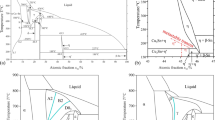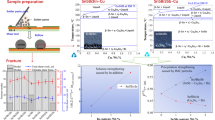Abstract
It is usually complicated to analyze the liquidus temperature of lead-free solder, because unlike Sn-Pb eutectic solder, supercooling easily occurs during the cooling process of lead-free solder, and common lead-free solders contain only a small fraction of a primary phase. In order to determine the melting temperature range of lead-free solder easily, an estimation method using differential scanning calorimetry (DSC) profiles is proposed. The purpose of this study is to show the applicability of the newly proposed DSC-based approach. DSC profiles using several heating rates were measured and analyzed. As a result, it was found that the extrapolated onset temperature, the peak temperature, and the extrapolated end temperature of the endothermic peak were proportional to the square root of the DSC heating rate. For lower heating rate, the temperature–axis intercept of the relationship between the square root of the heating rate and the peak temperature can be regarded as the liquidus temperature under equilibrium conditions with better accuracy. For higher heating rate, the temperature–axis intercept of the relationship between the square root of the heating rate and the extrapolated end temperature can be approximately estimated as the liquidus temperature of noneutectic lead-free solder under equilibrium conditions.
Similar content being viewed by others
References
T. Takemoto and M. Miyazaki, Mater. Trans. 42, 745 (2001).
S.H. Huh, K.S. Kim, and K. Suganuma, Mater. Trans. 42, 739 (2001).
S.W. Chen and Y.W. Yen, J. Electron. Mater. 30, 1133 (2001).
J.W. Yoon and S.B. Jung, J. Alloys Compd. 359, 202 (2003).
S.T. Kao, Y.C. Lin, and J.G. Duh, J. Electron. Mater. 35, 302 (2006).
H. Nishikawa, A. Komatsu, and T. Takemoto, J. Electron. Mater. 36, 1137 (2007).
F. Gao, H. Nishikawa, and T. Takemoto, J. Electron. Mater. 37, 45 (2008).
H.F. Hsu and S.W. Chen, Acta Mater. 52, 2541 (2004).
C. Chou and S.W. Chen, Acta Mater. 54, 2393 (2006).
C. Schmetterer, H. Flandorfer, and H. Ipser, Acta Mater. 56, 155 (2008).
S.-W. Chen and C.-C. Huang, Chem. Eng. Sci. 50, 417 (1995).
M.F. Fleszar, Thermochim. Acta 367–368, 273 (2001).
V.J. Kuch, Thermochim. Acta 99, 233 (1986).
R.P. Anjard, Microelectron. Reliab. 25, 9 (1985).
C.M. Miller, I.E. Anderson, and J.F. Smith, J. Electron. Mater. 23, 595 (1994).
I. Ohnuma, M. Miyashita, K. Anzai, X.J. Liu, H. Ohtani, R. Kainuma, and K. Ishida, J. Electron. Mater. 29, 1137 (2000).
M.E. Loomans and M.E. Fine, Metall. Mater. Trans. A 31, 1155 (2000).
K.W. Moon, W.J. Boettinger, U.R. Kattner, F.S. Biancaniello, and C.A. Handwerker, J. Electron. Mater. 29, 1122 (2000).
Japanese Industrial Standard: JIS Z 3198-1:2003.
W.J. Boettinger, U.R. Kattner, K.-W. Moon, and J.H. Perepezko, National Institute of Standards and Technology, Special Publication 960-15 (2006).
H.P. Thomas, Metrologia 27, 3 (1990).
R.E. Bedford, G. Bonnier, H. Maas, and F. Pavese, Metrologia 33, 133 (1996).
International Standard: ISO 9543:2006.
Author information
Authors and Affiliations
Corresponding author
Rights and permissions
About this article
Cite this article
Nishikawa, H., Hamada, Y. & Takemoto, T. Estimation Method for Liquidus Temperature of Lead-Free Solder Using Differential Scanning Calorimetry Profiles. J. Electron. Mater. 38, 2610–2616 (2009). https://doi.org/10.1007/s11664-009-0921-1
Received:
Accepted:
Published:
Issue Date:
DOI: https://doi.org/10.1007/s11664-009-0921-1




